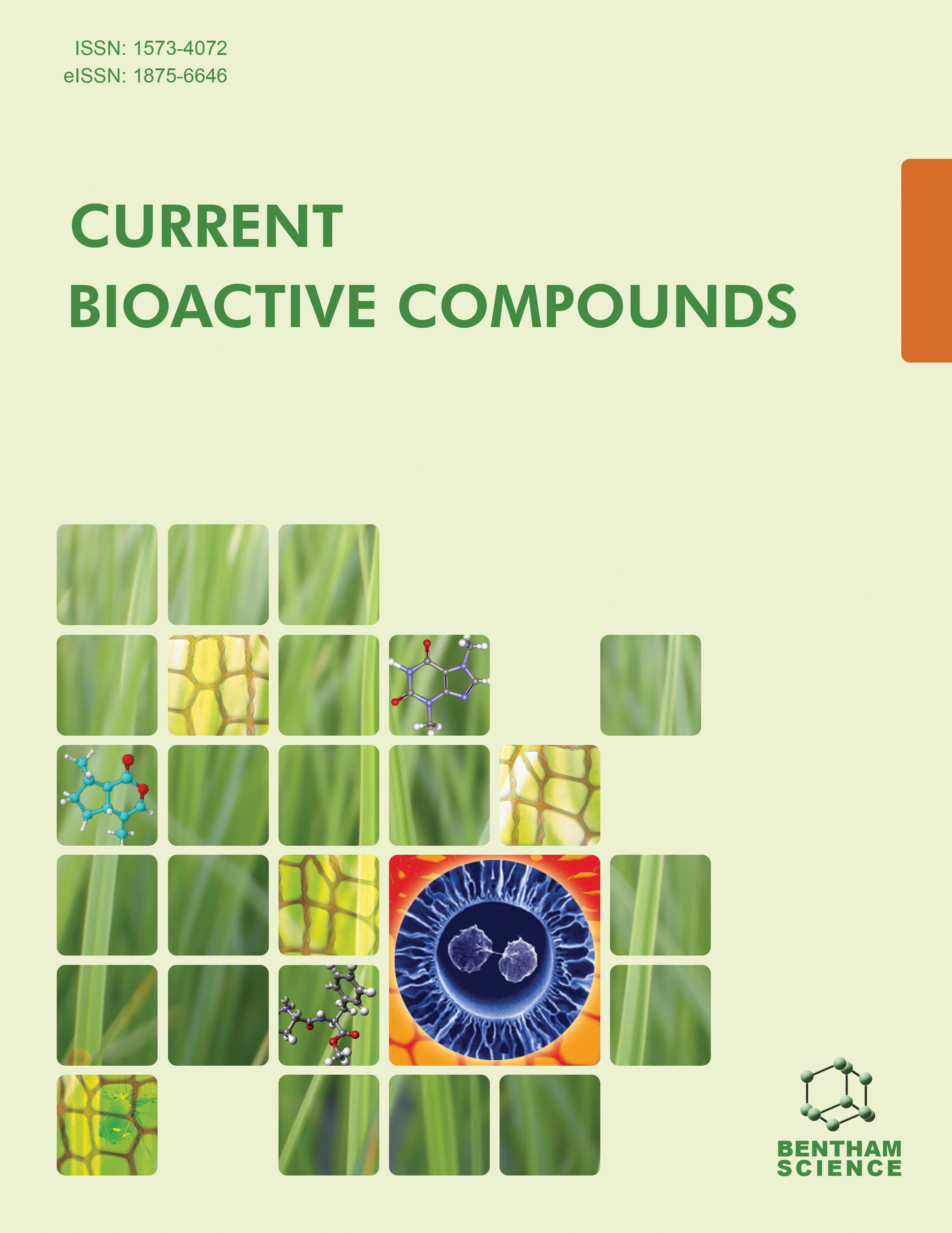- Home
- A-Z Publications
- Current Bioactive Compounds
- Previous Issues
- Volume 8, Issue 1, 2012
Current Bioactive Compounds - Volume 8, Issue 1, 2012
Volume 8, Issue 1, 2012
-
-
Preface
More LessCurrent Bioactive Compounds is now entering its 8th year of publication. Over the last seven years it has established itself as a very respectable journal in its field. The journal publishes authoritative reviews, original research and hot topic issues that are written by experts in the field on all the most important advances in bioactive compounds. The fields covered include new bioactive compounds of natural or synthetic origin wit Read More
-
-
-
Editorial [ Hot Topic: Monoterpenoids in Plant-Plant Interactions (Guest Editor: Prof. Vincenzo De Feo)]
More LessThis issue “Monoterpenoids in plant-plant interactions” highlights the ecological role of these compounds in nature, peculiarly in natural and modified ecosystems, updating available literature. Terpenoids are a group of secondary metabolites with a variety of functions, playing important roles in plant-plant, plantinsect and plant-pathogens interactions. The production and accumulation of secondary metabolites, which inhi Read More
-
-
-
Herbicidal Potential of Essential Oils from Three Mediterranean Trees on Different Weeds
More LessAuthors: Amri Ismail, Hamrouni Lamia, Hanana Mohsen and Jamoussi BassemThe essential oil composition of Juniperus phoniceae, Pistacia vera and Pistacia terebinthus was analyzed by GC and GC–MS analysis and their bioherbicidal activity was evaluated against four weeds species, Sinapis arvensis, Trifolium campestre (dicots), Lolium rigidium and Phalaris canariensis (monocots). Qualitative and quantitative differences between oils were observed. All oils were rich in monoterpene hydrocar Read More
-
-
-
Chemistry and Antigerminative Activity of Essential Oils and Monoterpenoids from Mediterranean Plants
More LessThe Mediterranean flora is characterized by the abundance of aromatic plants. The feature differentiating these plants from all others, in spite of the fact that they belong to many different families, is the production of chemically related secondary compounds, the low molecular weight and volatile isoprenoids. This remarkable presence of aromatic species is important in determining the phytotoxic potential within this ecosy Read More
-
-
-
Effects of Monoterpenes on Physiological Processes During Seed Germination and Seedling Growth
More LessThe mechanisms by which monoterpenes released by certain species affect the germination and growth of other plants remain to be elucidated. The information that is currently available suggests that they interfere with some physiological processes, including respiration, mitosis, the action of phytohormones, antioxidant defence systems and membrane properties. The data obtained by our group and other data from the lit Read More
-
-
-
Monoterpenoid Plant-Plant Interactions Upon Herbivory
More LessMonoterpene production by plants is not only dependent on the plant ability to produce secretory tissues where these molecules are accumulated. All plants are able to emit monoterpenes upon stress of both biotic and abiotic origin. Biotic stress induced by herbivory triggers the activation of signaling pathways eventually leading to the expression of genes coding for enzymes responsible for monoterpene emission. The emitte Read More
-
-
-
s Effect of Soil Nutrient on Production and Diversity of Volatile Terpenoids from Plants
More LessAuthors: E. Ormeno and C. FernandezTerpenoid production (emission and storage) within foliage plays direct and indirect defensive and protective functions for the plant, mediates complex trophic relationships and controls the oxidation capacity of the atmosphere. Both biotic and abiotic conditions alter terpenoid production, with herbivory, light and temperature effects being reasonably well understood. In this manuscript, the state of the science about nutrie Read More
-
-
-
Mode of Action of Monoterpenes in Plant-Plant Interactions
More LessThe abuse of synthetic pesticides in weed management causes serious environmental problems: disruption of ecological balance, harmful effects on human health and higher incidence of herbicide-resistant weeds. Due to this, efforts are being directed to develop new eco-friendly compounds with non-toxic effects and new modes of action. Some plant secondary metabolites are an important source to formulate new bioherbici Read More
-
-
-
oa Monoterpenes of Salvia leucophylla
More LessAuthors: Atsushi Sakai and Hiroko YoshimuraThe “Salvia phenomenon” is one of the most famous examples of allelopathic interaction between higher plants. The Salvia thickets are surrounded by zones of bare soil (“bare zone”, 1-3 m in width), which merge into areas of inhibited grassland (“zone of inhibition”) and finally undisturbed grassland at a distance of 3-9 m. This characteristic vegetation pattern was attributed to monoterpenes, especially 1,8-cineole and cam Read More
-
-
-
Role of Monoterpenes in Eucalyptus Communities
More LessAuthors: Shalinder Kaur, Harminder Pal Singh, Daizy R. Batish and Ravinder Kumar KohliThe Genus Eucalyptus (Myrtaceae) consisting of over 700 tall evergreen trees is widely distributed and extensively planted for wood, pulp, medicines and aesthetic values. The foliage of the tree is rich in essential oils that are used extensively in perfumery, pharmaceuticals and food industries, and are held responsible for a wide spectrum of biological activity of the tree. Additionally, the terpenoid rich essential oil also Read More
-
Volumes & issues
-
Volume 21 (2025)
-
Volume 20 (2024)
-
Volume 19 (2023)
-
Volume 18 (2022)
-
Volume 17 (2021)
-
Volume 16 (2020)
-
Volume 15 (2019)
-
Volume 14 (2018)
-
Volume 13 (2017)
-
Volume 12 (2016)
-
Volume 11 (2015)
-
Volume 10 (2014)
-
Volume 9 (2013)
-
Volume 8 (2012)
-
Volume 7 (2011)
-
Volume 6 (2010)
-
Volume 5 (2009)
-
Volume 4 (2008)
-
Volume 3 (2007)
-
Volume 2 (2006)
-
Volume 1 (2005)
Most Read This Month
Article
content/journals/cbc
Journal
10
5
false
en

Most Cited Most Cited RSS feed
-
-
Podophyllotoxin: Current Perspectives
Authors: Ying Qian Liu, Liu Yang and Xuan Tian
-
- More Less

